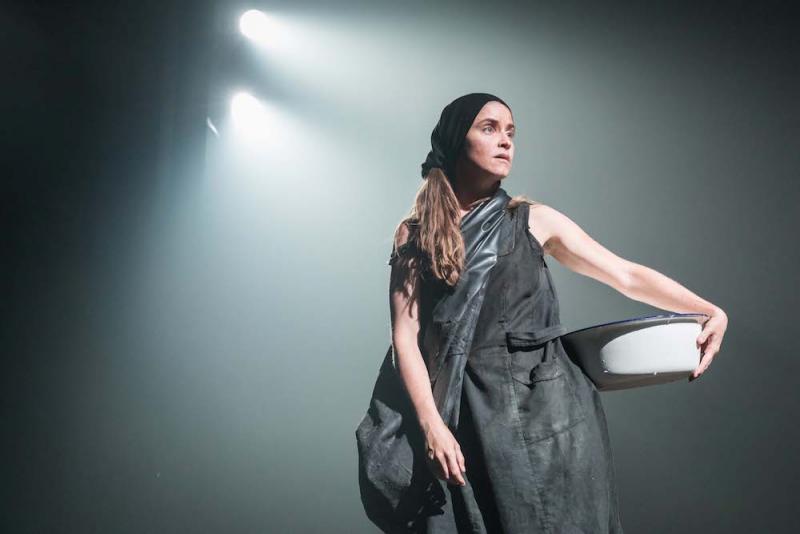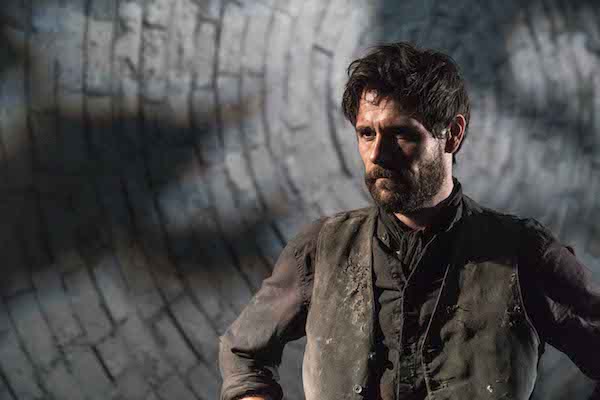Knives in Hens, Donmar Warehouse review – Yaël Farber not symbolic enough | reviews, news & interviews
Knives in Hens, Donmar Warehouse review – Yaël Farber not symbolic enough
Knives in Hens, Donmar Warehouse review – Yaël Farber not symbolic enough
The star director’s revival of a Nineties classic is atmospheric but unconvincing

Hark, is that the call of the earth I hear? In a frenetic urban world, the myth of rural simplicity exerts a strong pull. Surely a simpler life is possible; a more natural rhythm and a slower pace?
Set in a stretch of unspecified countryside, at an unspecified time in the pre-industrial past, where there is just a village, some fields and a mill, the story concerns three people: Pony William, the village ploughman, his wife, known only as Young Woman, and the local miller, Gilbert Horn. William labours hard, and keeps his wife on a short leash, helped by the fact that she believes in God. When she takes five sacks of grain to Gilbert to be milled into flour, local superstitions about his devilish nature jump out from the dark. Because he reads and writes, he is seen by the villagers as a demon who has magic powers. But she is strangely drawn to him.
Here words are like daggers – they're dangerous
This is a play about Young Woman’s search for her own identity, and shows how she makes sense of the world by learning to use words. At the start, she is confused because she cannot understand metaphors and similes (when her husband compares her to a field, she thinks “If I’m like a field must be a field”). Gradually, she successfully struggles for articulacy and self-expression, learning along the way how to handle the horses her husband seems determined to keep her away from. She also learns to trust Gilbert, who shows her a way out of the small universe of the village.
With its dreams, nightmares and moments of epiphany, this is an extremely difficult play to stage convincingly. Harrower asks us to believe that the Young Woman has learnt to write, even though she doesn’t really understand the use of words, and that she can master the pen as well as the stub of chalk. Perhaps it’s best understood as a highly symbolic fantasy that unfolds slowly, a bit like the thin cascades of flour that pour down every now and then in Farber’s production. It’s a dark fantasia that leads to knowledge, but also to death and guilt. To new desires and new understanding.
Harrower conjures up a world of grim belief, where the Young Woman thinks that God does everything, until she stumbles on a different reality. Her husband, meanwhile, wrestles with her beauty, seeing God in His creation, that is in her beautiful body. But when he asks Gilbert to look at her sleeping form, he provokes a fatal reaction. For the miller, who was married once and is now a widower, responds unexpectedly to the image of carnal delight that William plants inside his head. Once again, words are like daggers – dangerous. Finally, this is a story of how you can use words to lie. To create false realities, to form fictions and fantasies. As Young Woman discovers a feeling for nature, and matures in front of us, she also learns how to tell untruths. Her innate perceptiveness grows into a new worldview. One that she can more confidently control. On Soutra Gilmour’s dark set, dominated by a huge and elaborate milling stone, Farber retells this tale by emphasising and empathising with the passions of the characters, connecting more with their feelings than with the spare poetry of the piece’s language.
Finally, this is a story of how you can use words to lie. To create false realities, to form fictions and fantasies. As Young Woman discovers a feeling for nature, and matures in front of us, she also learns how to tell untruths. Her innate perceptiveness grows into a new worldview. One that she can more confidently control. On Soutra Gilmour’s dark set, dominated by a huge and elaborate milling stone, Farber retells this tale by emphasising and empathising with the passions of the characters, connecting more with their feelings than with the spare poetry of the piece’s language.
At the start, Farber begins by showing the agrarian heavy labour of the ploughman and his wife, her plucking a hen and him dragging the sacks of grain. She then shows their quick, brute copulation, and carefully and naturally illustrates the daily rituals of washing and eating. This stress on everyday reality comes at the expense of some of the symbolic language of the story. But if I’m not really convinced that Farber has found a strong enough stage language to convey this expressionistic play, most of the acting is good. Judith Roddy’s Young Woman grows visibly in her linguistic confidence, while Matt Ryan’s self-possessed Gilbert (pictured above) contrasts well with Christian Cooke’s more shifty William. Although not all of the dialogues are spoken clearly enough, this atmospheric production does, at its better moments, successfully traverse the liminal space between dream and reality.
- Knives in Hens at the Donmar Warehouse until 7 October
- Read more theatre reviews on theartsdesk
rating
Explore topics
Share this article
The future of Arts Journalism
You can stop theartsdesk.com closing!
We urgently need financing to survive. Our fundraising drive has thus far raised £49,000 but we need to reach £100,000 or we will be forced to close. Please contribute here: https://gofund.me/c3f6033d
And if you can forward this information to anyone who might assist, we’d be grateful.

Subscribe to theartsdesk.com
Thank you for continuing to read our work on theartsdesk.com. For unlimited access to every article in its entirety, including our archive of more than 15,000 pieces, we're asking for £5 per month or £40 per year. We feel it's a very good deal, and hope you do too.
To take a subscription now simply click here.
And if you're looking for that extra gift for a friend or family member, why not treat them to a theartsdesk.com gift subscription?
more Theatre
 The Line of Beauty, Almeida Theatre review - the 80s revisited in theatrically ravishing form
Alan Hollinghurst novel is cunningly filleted, very finely acted
The Line of Beauty, Almeida Theatre review - the 80s revisited in theatrically ravishing form
Alan Hollinghurst novel is cunningly filleted, very finely acted
 Wendy & Peter Pan, Barbican Theatre review - mixed bag of panto and comic play, turned up to 11
The RSC adaptation is aimed at children, though all will thrill to its spectacle
Wendy & Peter Pan, Barbican Theatre review - mixed bag of panto and comic play, turned up to 11
The RSC adaptation is aimed at children, though all will thrill to its spectacle
 Hedda, Orange Tree Theatre review - a monument reimagined, perhaps even improved
Scandinavian masterpiece transplanted into a London reeling from the ravages of war
Hedda, Orange Tree Theatre review - a monument reimagined, perhaps even improved
Scandinavian masterpiece transplanted into a London reeling from the ravages of war
 The Assembled Parties, Hampstead review - a rarity, a well-made play delivered straight
Witty but poignant tribute to the strength of family ties as all around disintegrates
The Assembled Parties, Hampstead review - a rarity, a well-made play delivered straight
Witty but poignant tribute to the strength of family ties as all around disintegrates
 Mary Page Marlowe, Old Vic review - a starry portrait of a splintered life
Tracy Letts's Off Broadway play makes a shimmeringly powerful London debut
Mary Page Marlowe, Old Vic review - a starry portrait of a splintered life
Tracy Letts's Off Broadway play makes a shimmeringly powerful London debut
 Little Brother, Soho Theatre review - light, bright but emotionally true
This Verity Bargate Award-winning dramedy is entertaining as well as thought provoking
Little Brother, Soho Theatre review - light, bright but emotionally true
This Verity Bargate Award-winning dramedy is entertaining as well as thought provoking
 The Unbelievers, Royal Court Theatre - grimly compelling, powerfully performed
Nick Payne's new play is amongst his best
The Unbelievers, Royal Court Theatre - grimly compelling, powerfully performed
Nick Payne's new play is amongst his best
 The Maids, Donmar Warehouse review - vibrant cast lost in a spectacular-looking fever dream
Kip Williams revises Genet, with little gained in the update except eye-popping visuals
The Maids, Donmar Warehouse review - vibrant cast lost in a spectacular-looking fever dream
Kip Williams revises Genet, with little gained in the update except eye-popping visuals
 Ragdoll, Jermyn Street Theatre review - compelling and emotionally truthful
Katherine Moar returns with a Patty Hearst-inspired follow up to her debut hit 'Farm Hall'
Ragdoll, Jermyn Street Theatre review - compelling and emotionally truthful
Katherine Moar returns with a Patty Hearst-inspired follow up to her debut hit 'Farm Hall'
 Troilus and Cressida, Globe Theatre review - a 'problem play' with added problems
Raucous and carnivalesque, but also ugly and incomprehensible
Troilus and Cressida, Globe Theatre review - a 'problem play' with added problems
Raucous and carnivalesque, but also ugly and incomprehensible
 Clarkston, Trafalgar Theatre review - two lads on a road to nowhere
Netflix star, Joe Locke, is the selling point of a production that needs one
Clarkston, Trafalgar Theatre review - two lads on a road to nowhere
Netflix star, Joe Locke, is the selling point of a production that needs one
 Ghost Stories, Peacock Theatre review - spirited staging but short on scares
Impressive spectacle saves an ageing show in an unsuitable venue
Ghost Stories, Peacock Theatre review - spirited staging but short on scares
Impressive spectacle saves an ageing show in an unsuitable venue

Add comment